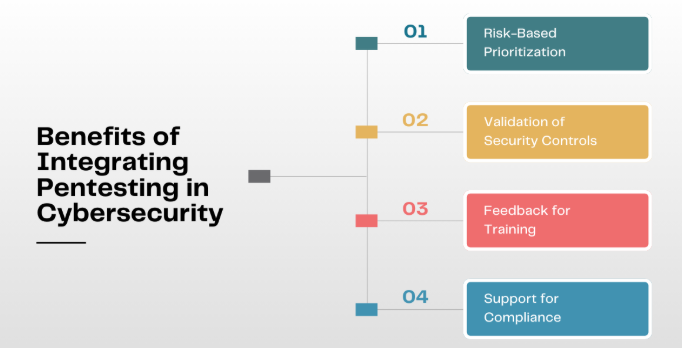Modern organizations rely on modern technologies. Technology adoption, in turn, makes processes better, efficient and faster. However, nobody wants unexpected behavior from these systems. But often, cyberattacks exploit vulnerabilities to disrupt the normal functioning of digital assets, causing catastrophic consequences for business organizations. Penetration Testing leads the charge for organizations who see security as priority instead as an afterthought. Because this cybersecurity exercise helps achieve true resilience.
This blog reveals how pentesting is a high impact cybersecurity practice. Plus, you will learn why its integration is essential for business continuity and how organizations can align testing with long-term resilience goals.
Why Business Continuity Needs More Than Traditional Security
Before answering the “why” question, let’s begin with “what.” So, what does business continuity mean? It can be understood as the ability of your organization to keep running the key operations in time of a (during and after) crisis. As you see, traditionally, continuity planning was always focused on natural disasters, system outages and supply chain failures. Today, cyber threats are perhaps at the top of that list.
Why is this so? Consider an example of ransomware. A single successful ransomware attack against your IT system can lock down critical systems, halt customer transactions and compromise sensitive data. What about the irreparable reputational damage? Therefore, businesses continuity planning today without discussing cybersecurity is a huge risk for any organization, across industries.
This is where pen testing services level the playing field against cyber attackers. It simulates real-world threats (similar to how hackers operate) to uncover vulnerabilities early in your system.
What Is a Penetration Testing Service?
A penetration testing service is a practice where pentesters exploit all possible vulnerabilities existing in your IT infra and expose which can be potentially dangerous.
Due permission is taken from key stakeholders, security leaders and other leadership people to conduct pentest in applications, processes and sometimes on people. The pentesters use tactics, techniques, tools and processes (TTPs) as malicious actors. But as you can understand, the goal here is to identify weaknesses before criminals can exploit them.
Penetration testing involves human creativity. Therefore, testers go beyond surface-level flaws, connecting issues across systems to demonstrate the actual business impact of an attack.
The Shift Toward Integrated Cybersecurity
For far too long, penetration testing services have been thrown around as a one-off project in a year for businesses. But that time is gone. Today, businesses need continuous pentesting or at least quarterly testing.
Also, companies used to opt for pentesting before an audit or compliance deadline. However, regulatory bodies like CERT-In now encourage regular testing.
Integrate penetration testing with a broader cybersecurity framework and see your business turn proactive from reactive.
Key benefits of integration include:

Risk-Based Prioritization: Pen testing highlights which vulnerabilities present the greatest risk to business operations.
Validation of Security Controls: Testing shows whether existing defenses like intrusion detection or endpoint protection are functioning as intended.
Feedback for Training: Results can guide awareness programs, showing employees where phishing or social engineering defenses need reinforcement.
Support for Compliance: Regular testing ensures readiness for audits across standards like PCI DSS, HIPAA, and ISO 27001.
Pentesting Example: A Retail Company’s Cyber Resilience Journey
Imagine you have a mid-sized retail company. You invested heavily in firewalls, endpoint security and cloud tools. The leadership in your company believed they are
well-protected until you decided to run a penetration test, which uncovered multiple risks like:
- Weak company password policies allowed testers to crack admin credentials in hours.
- A web or mobile application vulnerability exposed sensitive customer and payment data.
- Employees were easily tricked into sharing access details during a simulated phishing attempt.
Instead of treating these findings as isolated issues, the company integrated them into its risk management framework. IT teams patched systems, HR revamped security training, and executives invested in incident response planning. The result didn’t just improve cybersecurity—it became a stronger foundation for business continuity.
Types of Penetration Testing Services for Integrated Security
As technologies grow, the need to pentest every component also increases Hence, here are the common pentesting types relevant today:
Network Penetration Testing: Identifies weaknesses in internal and external networks.
Web Application Testing: Explores vulnerabilities in customer-facing portals or internal applications such as websites.
Cloud Penetration Testing: Assesses risks in cloud-based services and configurations.
Mobile Application Testing: Ensures mobile platforms do not have weak entry points.
Social Engineering Tests: Simulates phishing or manipulation attacks targeting employees.
How Pen Testing Services Enhance Business Continuity
Penetration testing contributes directly to resilience by:
Minimizing Downtime: By addressing vulnerabilities proactively, businesses reduce the likelihood of disruptions.
Protecting Reputation: Preventing breaches preserves customer trust and brand credibility.
Reducing Recovery Costs: Fixing vulnerabilities before an incident is far cheaper than post-breach recovery.
Building Confidence: Stakeholders, investors, and regulators gain confidence when businesses demonstrate a proactive security posture.
What are Some Common Objections to Pentesting?
We understand that it is not easy for security leaders to convince the organizational heads like CEOs and founder about investing in pentesting. In our experience, many organizations remain reluctant due to misconceptions. They are addressed here:
- “It’s too expensive” has to be the most common objection we have heard. However, if you really take a deeper look, the cost of testing is and will always be less when compared to the financial losses caused by the effects of a data breach.
- “It might disrupt operations.” Second prominent objection. Although somewhat true, experienced, CERT-In empaneled and professional testers coordinate well to minimize risks, conducting tests in controlled environments.
- “We already have strong security tools.” Now that can be true but not always efficient. Even advanced tools are unable to replicate the adaptability and persistence of human attackers.
Taking the First Step
So, how to integrate penetration testing with broader cybersecurity strategy? Begin by scheduling regular assessments, aligning results with risk management priorities. And use the findings to refine policies, tools and employee training.
For businesses looking to strengthen their defenses, engaging with a trusted Penetration Testing Service Provider is an effective way to uncover hidden risks and take action before attackers do.
Conclusion
Modern business continuity depends on technology. But it also depends on how you secure your technologies and operations from modern threats. Cyber resilience is the key today. What worked 5 years ago won’t work now. Penetration testing also provides the visibility and assurance businesses need to adapt.
When you integrate pen testing services into the unified cybersecurity strategy, positive things happen. Like what? Organizations identify vulnerabilities fast, strengthen controls and build confidence among stakeholders. Beyond protection, penetration testing services help operate, grow and thrive in a digital-first world.
To explore more resources on building resilient cybersecurity strategies, visit CyberNX.








